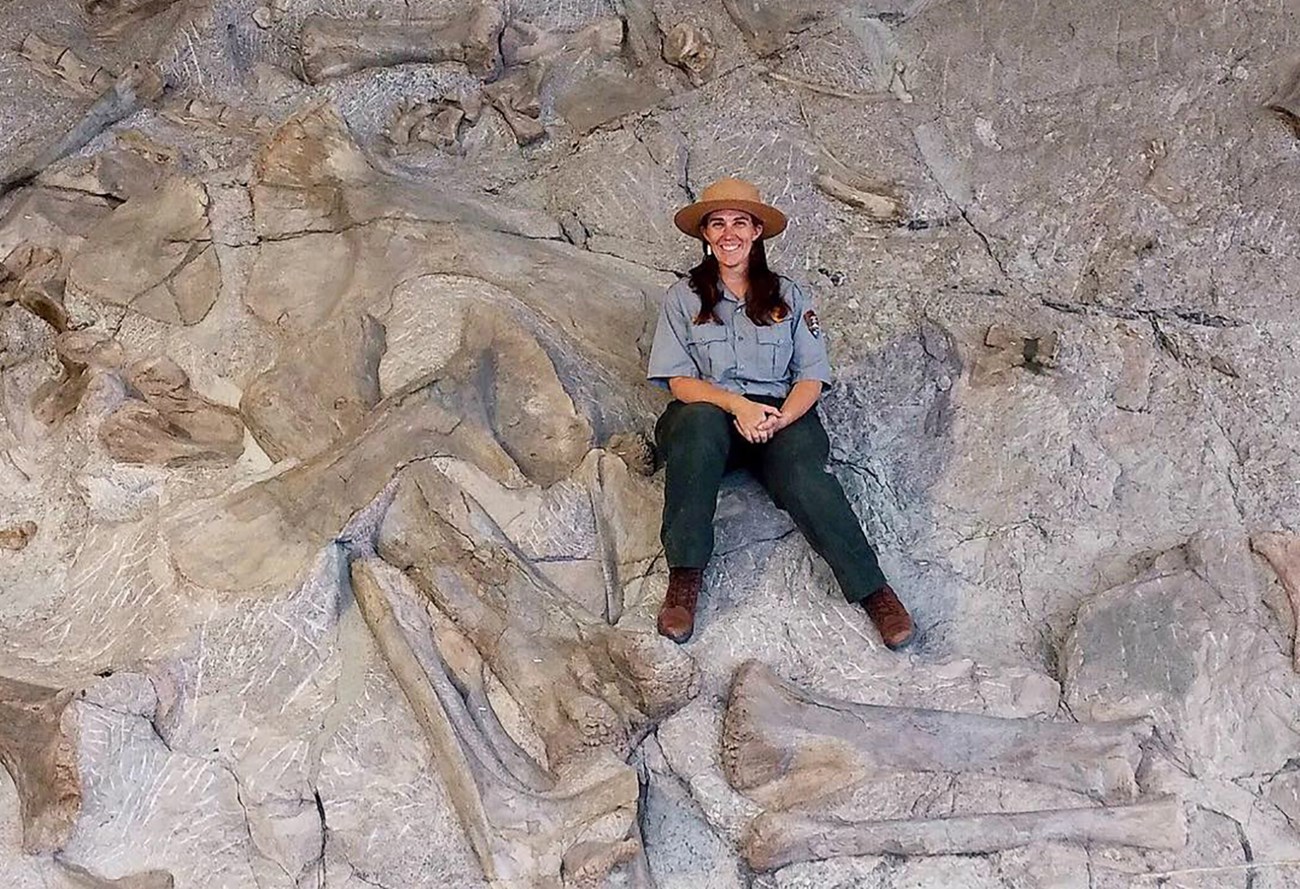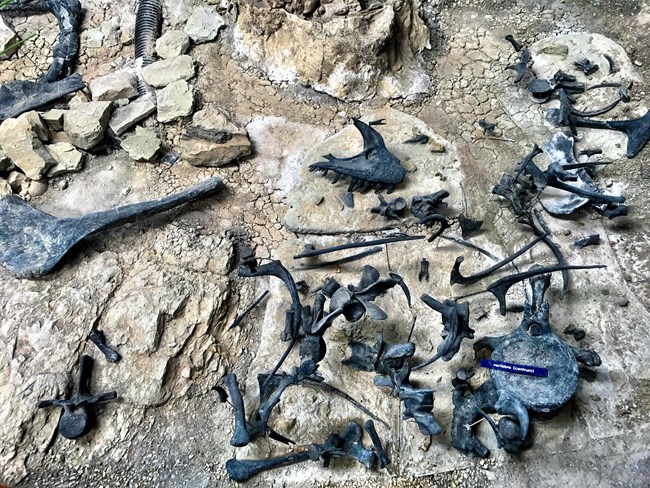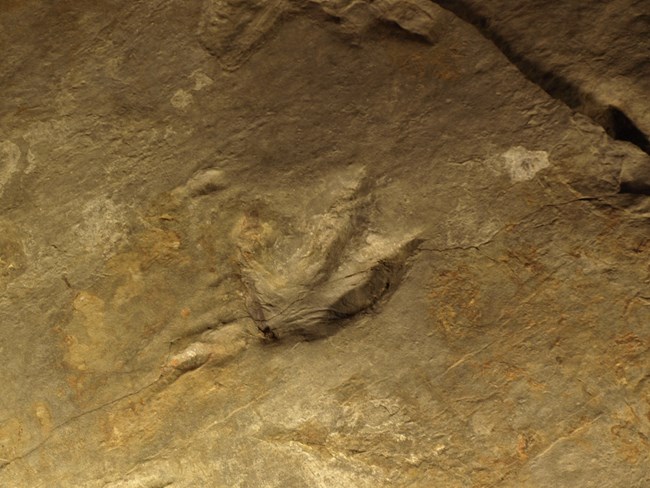
NPS photo.
Introduction
Leaving aside birds, none of us has seen a living dinosaur. Yet, we know they were real (even if some of our attempts to illustrate them are far away from reality!). How do we know about them, then? All of our direct evidence of dinosaurs comes from the geologic record: from Triassic, Jurassic, and Cretaceous sedimentary rock formations around the world. Sedimentary rocks are those that are made up of materials deposited at the Earth’s surface, e.g., sediments. Think mostly sand, silt, mud, and pebbles, with some cases of chemical deposition of lime, or marine “rain” of tiny plankton pieces. Most dinosaur fossils are found in rocks deposited by ancient rivers, because the rivers moved enough sediment to bury dinosaur remains.
Becoming a Fossil
Becoming a fossil is pretty rare for a large land animal. Although we have fossils of many individual dinosaurs, this represents only an extremely small fraction of all those that ever lived. Fossils require burial. It is easiest to become a fossil when you have hard body parts, live in water, and have a small body. This is why most fossils are of marine organisms such as shellfish, corals, and plankton with hard outer coverings. In most cases when a land animal dies, its remains are quickly scattered and destroyed. Even if it does end up under water, you can imagine how hard it would be to entirely bury something bigger than an elephant. Would you be surprised to know that most dinosaurs are only known from single bones or partial specimens? Our best dinosaur fossils come from times and places where the animals were rapidly buried, such as in a river moving a lot of sediment, or in a floodplain behind a broken natural levee, or around a lake following the eruption of a nearby volcano producing lots of volcanic ash. There are whole ecosystems of dinosaurs we’ll never know about, because the right conditions for deposition were rare, or any rocks that formed have been eroded. Think of places like Mesozoic islands that have been weathered beneath the sea, or upland areas that didn’t have places for sediment to accumulate. Some entire continents were like this; for example, almost all dinosaur fossils from Australia date to a little slice of the middle Cretaceous. Scientists suspect that we have poor fossils of pachycephalosaurs in North America because they preferred upland areas, and the only parts of them that could withstand tumbling down rivers were their thick skull domes.
Body Fossils

NPS photo.
Dinosaur fossils come in two forms: body fossils and trace fossils. Body fossils are what we usually think of when we think of dinosaurs: bones, teeth, bony armor, rare soft tissue impressions, and so on. Most of the time, a dinosaur body fossil represents a dead dinosaur, but this isn’t necessarily true of teeth, because dinosaurs constantly replaced their teeth. Soft tissue impressions are usually of the skin. Depending on the depositional conditions and the kind of dinosaur, non-overlapping polygonal scales or feathers may be seen. Sometimes a dinosaur carcass has been preserved as a natural “mummy” with widespread skin impressions.
Trace Fossils

NPS photo
Dinosaur trace fossils are records of the activity of a living dinosaur. Most dinosaur trace fossils are footprints. Dinosaur tracks and body fossils are not usually found preserved in the same rocks, but there are some exceptions. Dinosaur tracks in Upper Triassic, Lower Jurassic, and Middle Jurassic rocks in the U.S. tell us a lot about dinosaurs that are poorly known from bones. Dinosaur tracks can be seen at many parks in the Colorado Plateau. The study of dinosaurs in North America began in New England in the early 19th century with the discovery of abundant tracks roughly 200 million years old. Dinosaur State Park National Natural Landmark in Connecticut is an example of a New England track site. Another kind of trace fossil produced by dinosaurs is coprolites, also know as fossil feces. Most of the coprolites that have been found were left by carnivores because the chemistry of meat is more favorable for preservation. Large hadrosaur coprolites have also been found. They show that some ate rotted wood and crustaceans on occasion. Dinosaur eggshells are kind of like body fossils and kind of like trace fossils, so not everyone agrees about how to describe them, but we’ll include them with trace fossils. You might think it would be easy to tell what dinosaurs produced certain eggs, but it is rare to find the delicate bones of dinosaur embryos with eggs. Concretions and rounded rocks are often mistaken for dinosaur eggs, but real dinosaur egg fossils rarely look like whole eggs; instead, they are often squashed and distorted, which isn’t surprising when you think about how easy it is to damage a modern egg. It’s also easier to preserve a fragment of an egg instead of a whole egg.
Site Index and Credits
Age of Dinosaurs (2021)
Text by Justin Tweet (AGI). Contributors: Vincent Santucci (GRD), Adam Marsh (PEFO), ReBecca Hunt-Foster (DINO), Don Corrick (BIBE). Project Lead / Web Development, Jim Wood (GRD).
References
-
Tweet, J.S. and V.L. Santucci. 2018. An Inventory of Non-Avian Dinosaurs from National Park Service Areas. in Lucas, S.G. and Sullivan, R.M., (eds.), Fossil Record 6. New Mexico Museum of Natural History and Science Bulletin 79: 703-730. https://irma.nps.gov/DataStore/Reference/Profile/2257153
-
Santucci, V.L., A. Marsh, W. Parker, D. Chure, and D. Corrick, 2018. “Age of Reptiles”: Uncovering the Mesozoic Fossil Record in three Intermountain national parks. IMR Crossroads. Spring 2018, p. 4-11. https://irma.nps.gov/DataStore/Reference/Profile/2253529
Last updated: July 8, 2022
